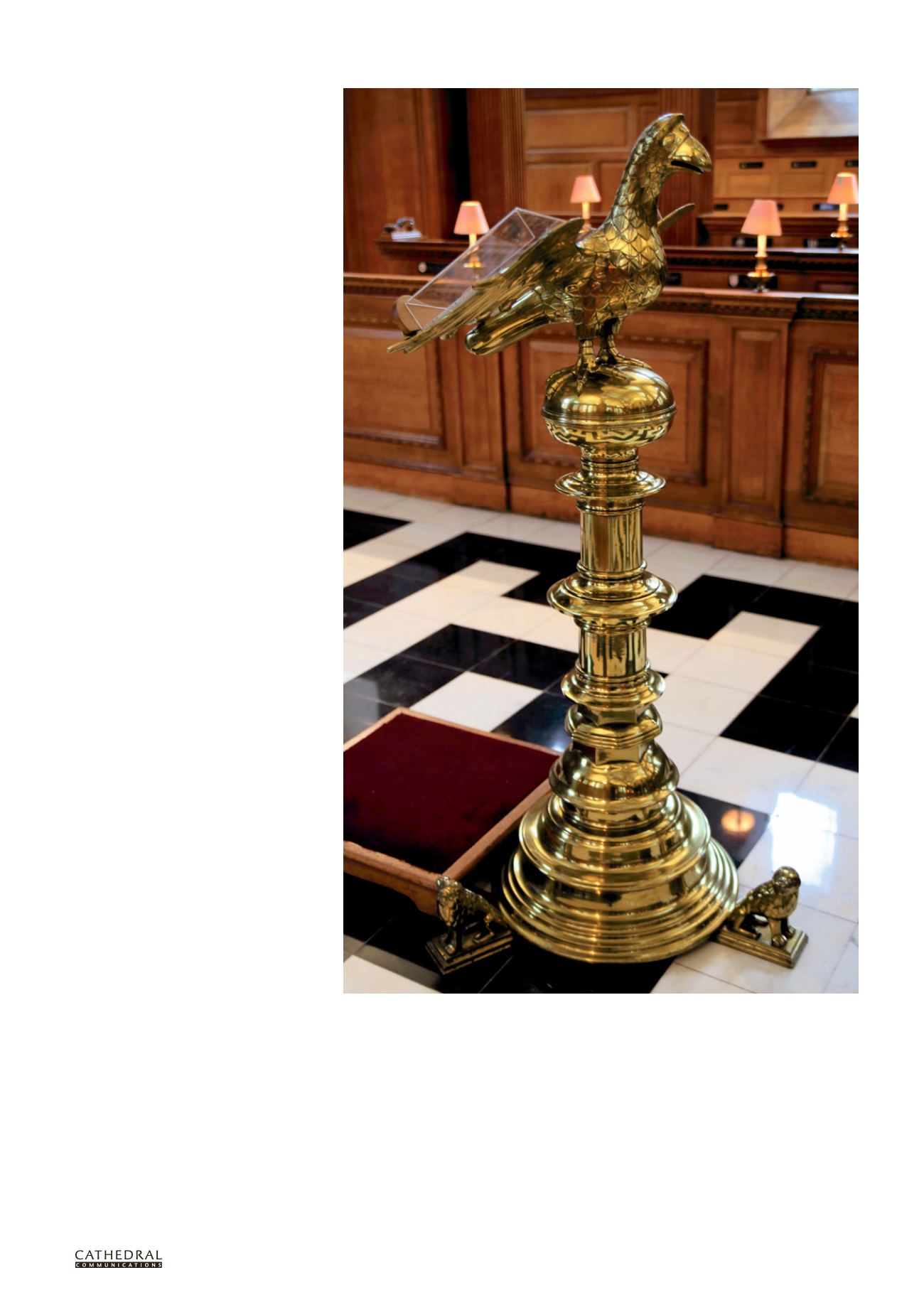

BCD SPECIAL REPORT ON
HISTORIC CHURCHES
24
TH ANNUAL EDITION
25
In 1539 the Great Bible was presented
and a copy had to be displayed for all to
consult. Freestanding bookstands like
the brass eagle lectern already present in
some houses of worship could fulfil the
task perfectly. In the Church of St Petrock,
Exeter, the lectern was placed in ‘the
body of the church, to set the Bible on’.
The inventory of 1554 describes ‘an egle
of latten whiche ys to leye the Bible on’ in
the church of Havering, Greater London.
Of all the brass eagle lecterns in England
dating from before the Gothic Revival
of the 19th century and the industrial
output that followed, a surprisingly large
number can be dated to between 1470 and
1530. Only one is earlier and can truly be
called medieval, that of Holy Rood Abbey,
Southampton, today at St Michael’s
Church. From the 18th century two
survive, one at Brasenose College, Oxford,
the other at St Paul’s Cathedral. Less than
a dozen were made in the 17th century,
and none during the Commonwealth.
Yet a staggering 40 or so survive from
the relatively short period between the
end of the Wars of the Roses and the
beginning of the English Reformation.
THE DECLINE
The consequences for the church interior
could not have been anticipated when
Henry VIII broke away from Rome in 1534.
In the process the liturgy was reformed,
heralding a rising influence of protestant
attitudes towards idolatry, with radical
implications for the church interior.
At Westminster Abbey the sale of
two brass lecterns was ordered by the
chapter in 1549 as they were ‘monuments
to idolatry and superstition’. The
supposed profanity can be explained
by the iconographical connotations of
the eagle. It is a symbol of St John the
Evangelist, whose Gospel starts with the
words
In principio erat Verbum
(‘In the
beginning was the Word’), so there was
a symbolic connection between the
eagle and the Bible which rested on its
wings – the word of God. The eagle is
one of the four animals of Ezekiel, a
tetramorph which is completed by the
bull for Luke, the lion for Mark and an
angel for Matthew. Depictions based
on texts in the Bible were accepted
by many early protestants. One of the
earliest Lutheran church interiors,
the chapel at Wilhelmsburg Castle
in Schmalkanden, features a curious
altar-cum-font supported by all four
creatures from Ezekiel’s vision.
Yet another connotation of the eagle
could be regarded as outright blasphemy.
The
Physiologus
, a medieval encyclopedia
describing the earth as an allegory of
Brass eagle lectern c1500 at Wren’s Church of St Bride, Fleet Street, London (Photo: Marcus van der Meulen)
heaven, regards the eagle as the King
of Heaven. In the 13th century Thomas
Aquinas wrote ‘as an Eagle He [Christ]
ascended aloft into heaven’. As an allegory
for Christ, the brass eagle lectern was the
epitome of the idolatry which Puritans
wished to excise.
The
Physiologus
also provides an
explanation for the pelican’s significance,
claiming that the bird would pierce its
own breast to feed or revive its brood.
In one of his Eucharistic hymns for the
Feast of Corpus Christi (1264) Thomas
Aquinas made the connection with Christ
even clearer:
Pie Pellicane, Iesu Domine.
Me immundum mundo tua sanguine
(‘Pious pelican, Lord Jesus, cleanse
me, impure one, in your blood’). The
pelican thus provided the church with a
vibrant allegory for Christ, his sacrifice


















